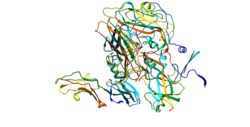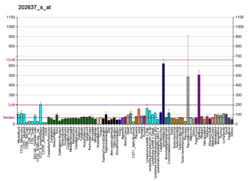Other functions
ICAM-1 and soluble ICAM-1 have antagonistic effects on the tight junctions forming the blood-testis barrier, thus playing a major role in spermatogenesis. [14]
The presence of heavy glycosylation and other structural characteristics of ICAM-1 lend the protein binding sites for numerous ligands. ICAM-1 possesses binding sites for a number of immune-associated ligands. Notably, ICAM-1 binds to macrophage adhesion ligand-1 (Mac-1; ITGB2 / ITGAM), leukocyte function associated antigen-1 (LFA-1), and fibrinogen. These three proteins are generally expressed on endothelial cells and leukocytes, and they bind to ICAM-1 to facilitate transmigration of leukocytes across vascular endothelia in processes such as extravasation and the inflammatory response. As a result of these binding characteristics, ICAM-1 has classically been assigned the function of intercellular adhesion.
Researchers began to question the role of ICAM-1 as a simple adhesion molecule upon discovering that ICAM-1 serves as the binding site for entry of the major group of human rhinovirus (HRV) into various cell types. [8] ICAM-1 also became known for its affinity for Plasmodium falciparum -infected erythrocytes (PFIE), acting synergistically in mediating adherence of PFIE to endothelium co-expressing CD36, providing more of a role for ICAM-1 in infectious disease. [15]
With the roles of ICAM-1 in cell-cell adhesion, extravasation, and infection more fully understood, a potential role for ICAM-1 in signal transduction was hypothesized. Most of the work involving ICAM-1 in recent years has focused on this central question as well as related questions. Researchers reasoned that, should ICAM-1 signal transduction prove to occur, it would be necessary to identify the mechanism of that signaling, the conditions and environment in which the signaling would occur, and the biological endpoints of any signaling cascades involved. Beyond its classically described functions as an adhesion and viral entry molecule, ICAM-1 has now been characterized convincingly as possessing a role in signal transduction. Furthermore, the signal-transducing functions of ICAM-1 seem to be associated primarily with proinflammatory pathways. In particular, ICAM-1 signaling seems to produce a recruitment of inflammatory immune cells such as macrophages and granulocytes. [16]
ICAM-1 may also participate in a positive feedback loop and compete with ICAM-2 to maintain a proinflammatory environment conducive to leukocyte endothelial transmigration. At both the mRNA and protein levels of expression, ICAM-1 ligation was found to upregulate ICAM-1’s own expression in a positive-feedback loop. In addition, the expression of RANTES mRNA and protein was also found to be upregulated by ICAM-1 ligation. RANTES, or Regulated upon Activation Normal T-cell Expressed and Secreted, is a cytokine that is an inflammatory mediator chemotactic for a variety of inflammatory immune cells such as granulocytes and macrophages. [17] However, much work remains to be done in fully characterizing the signaling of ICAM-1. The relationship between ICAM-1 and ICAM-2 signaling environments has not been established beyond mere correlation; a study linking ICAM signaling to actual modulation of an inflammatory environment in vivo has yet to be conducted. The reticular nature of signaling cascades necessitates that the downstream effectors of ICAM-1 mediated signaling through various kinases including p56lyn, Raf-1, and the MAPKs are largely unknown. A more thorough study of the cross-talk between these signaling molecules may shed further light onto the biological endpoints produced by ICAM-1 ligation and signal transduction.












